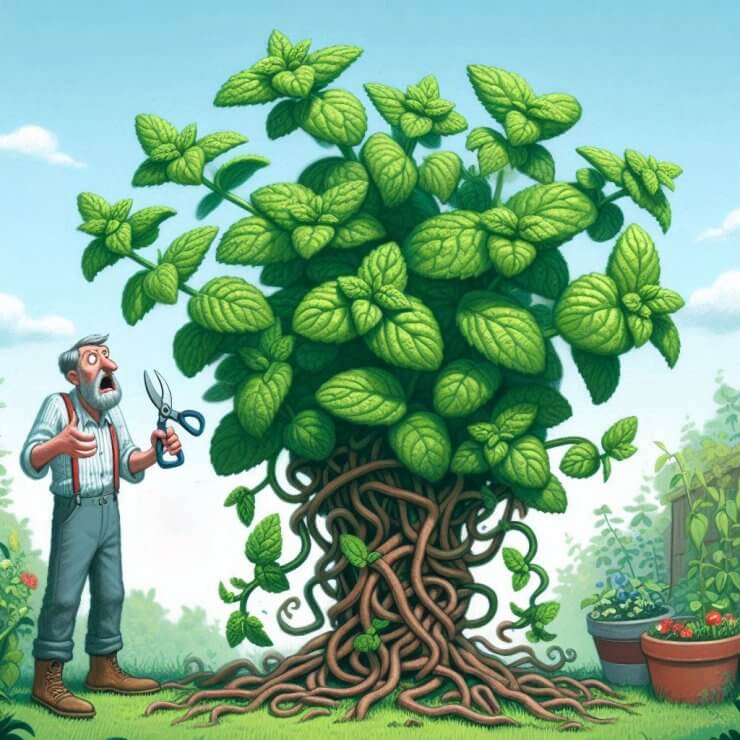Read by Michael Flamel

Ah, mint. The herb that brings freshness to your dishes, zest to your beverages, and chaos to your garden! My journey with mint began as a child, assisting my father, a professional chef, in our family garden. Those early experiences taught me valuable lessons, not the least of which was that mint is the Houdini of herbs—escaping and taking over every inch of our garden until my father had to dig it out completely, excavating down to about 18 inches and bringing in new topsoil. From this early lesson, I learned that mint is best grown in containers to keep it, well, contained.
A Brief History of Mint
Mint, a perennial herb, has been delighting humans for millennia. It is believed to have originated in the Mediterranean region, where it was prized for its medicinal and culinary uses. The Greeks and Romans used mint to flavor their sauces, wines, and even as a perfume. In ancient times, mint was considered a symbol of hospitality. It was commonly strewn across floors to freshen the air in homes and banquet halls. Fast-forward to the Middle Ages, when mint was used to whiten teeth and as a breath freshener. Today, it’s a staple in kitchens, bars, and gardens around the world.
Growing Mint: A Garden Takeover
If there’s one thing I can assure you, it’s that there’s probably no plant easier to grow than mint. This hardy herb can thrive in a variety of conditions but give it an inch, and it will take a mile (and then some). My father and I learned this the hard way. What started as a few innocent sprigs quickly turned into a mint invasion, displacing all manner of other herbs and vegetables. After a thorough excavation, we realized the best approach was to grow mint in containers, keeping it in check.
Here are some tips for growing mint:
Containers are Key: Plant mint in a container to prevent it from spreading uncontrollably. Even if you plant it in the ground, consider sinking the container to restrict its roots.
Light and Soil: Mint prefers partial shade and moist, well-drained soil. However, it’s quite forgiving and can adapt to various conditions.
Watering: Keep the soil consistently moist, especially during hot weather. Mint loves water but doesn’t like to sit in soggy soil.
Indoor Growing: Mint is probably the easiest herb to grow indoors. Place it on a sunny windowsill and enjoy fresh mint all Winter long.
Fun Facts About Mint
There are over 600 varieties of mint, including peppermint, spearmint, chocolate mint, and apple mint.
Mint has been used medicinally to treat everything from digestive issues to headaches.
In ancient Greece, students would wear crowns of mint to improve their concentration and learning abilities.
Mint’s aromatic properties come from its high menthol content, which is why it’s used in toothpaste, chewing gum, and balms.
Using Mint in Recipes and Beverages
Mint is a versatile herb that can elevate a wide range of dishes and drinks. Here are some delightful ways to use mint:
1. Mojitos and Mint Juleps
Mojito: Mix fresh mint leaves with sugar and lime juice, then add rum, soda water, and ice for a refreshing cocktail.
Mint Julep: Combine mint, sugar, and bourbon over crushed ice for a classic Southern drink.
2. Mint Tea
Brew fresh mint leaves in hot water for a soothing and aromatic tea. This truly multi-century experience is a must-try.
3. Culinary Uses
Add mint to salads, dressings, and marinades for a burst of freshness.
Use it in desserts like mint chocolate chip ice cream or as a garnish for fruit salads.
Happy Gardening!
Growing mint is a rewarding experience, providing you with a lush green and aromatic herb that can spice up your recipes and cocktails. Just remember to keep it contained to avoid a minty takeover. Whether you’re brewing a cup of mint tea or mixing up a mojito, mint is sure to bring joy to your kitchen and garden.
Happy gardening, and may your mint grow as wild as your imagination (but only within its container)!
This playful recount of my escapades with mint is a testament to the herb’s vigorous nature and myriad uses. Enjoy the journey of growing and using mint, but remember to keep it in check, lest it takes over your garden like it did ours! ❖


 Previous
Previous

